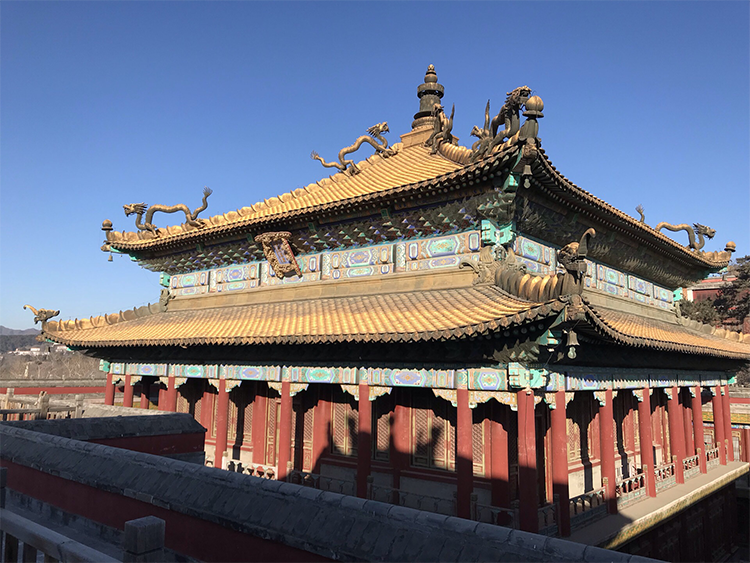Tibetan Buddhist Temple in Chengde: Explore the Little Potala Palace
Introduction:
Nestled among the verdant peaks of Chengde in Hebei province stands a striking red-and-white complex that channels the sacred grandeur of the Tibetan plateau while reflecting imperial Chinese scale and craft. This is Putuo Zongcheng Temple—often called the “Little Potala Palace.” Born from Emperor Qianlong’s filial devotion and political vision, it is a living monument to Tibetan Buddhism, ethnic unity, and Qing-era artistry. A walk here traverses history, art, and devotion.
1. Soul Snapshot: Tibetan Style Meets Imperial Majesty
Putuo Zongcheng Temple is the largest of the Qing dynasty’s Outer Eight Temples and was modeled after Lhasa’s Potala Palace. It skillfully blends Tibetan forms with Han glazed tiles, painted decoration, and Chinese architectural details, making it a celebrated example of Han–Tibetan synthesis. More than a temple, it is Qianlong’s memorial to his mother and a tangible expression of imperial policy toward frontier peoples.
2. Historical Evolution: From Imperial Celebration to World Heritage
Commissioned in 1767 to celebrate the Qianlong Emperor’s mother’s 80th birthday and to strengthen ties with Mongolian and Tibetan communities, the complex rose in roughly four years to cover about 220,000 square meters as a scaled replica of the Potala.
– Religious status: A major Gelug (Yellow Hat) center, the temple hosted visiting Dalai and Panchen Lamas and enjoyed vibrant ritual activity.
– Cultural significance: In 2010 Putuo Zongcheng Temple and the Chengde Mountain Resort were inscribed as UNESCO World Heritage sites, praised as a three-dimensional textbook of Qing-era ethnic and religious policy.
3. Architecture and Art: The Faith Code Between Red and White Terraces
Layout: More than 40 red living-terraces (monk quarters), white shrines (Buddha halls), and pagoda towers stagger up the slope, symbolizing Mount Meru and Buddhist cosmology.
– The Great Red Terrace: The central red building rises 42.5 meters and features blind Tibetan-style windows. Inside are thousands of gilded and bronze Buddha figures; prayer flags cast shifting light on the gilt statues, producing a solemn, mysterious atmosphere.
– Five-Pagoda Gate: Five colorful pagoda-style towers stand atop a Han-style glazed gateway, representing the Five Wisdom Buddhas and exemplifying Han–Tibetan artistic fusion.
– Artistic treasures: Qianlong’s gilt inscription plaque reading “Putuo Zongcheng Temple,” exquisite thangka murals, and masterfully gilded sculptures represent the peak of Qing Buddhist art.

4. Immersive Experience: Circumambulation, Blessings, and Quiet Healing
– Daily rituals: Early-morning chants from resident lamas fill the halls—visitors may observe respectfully and must keep silence.
– Participation tips:
– Walk clockwise around the Great Red Terrace and its prayer wheels to accumulate merit.
– Offer a hada (prayer scarf) at the white shrines; hadas are sold outside the temple—observe local etiquette when presenting them.
– Special event: The annual “Jump Buza” festival (a form of masked Vajra or cham dance) on the lunar 15th day of the sixth month is an exceptional moment to experience Tibetan liturgical performance.
5. Environment and Atmosphere: Sacred Calm in the Mountains
– Who you’ll meet: Devotees of Tibetan Buddhism, photographers, and students of history and culture coexist here in respectful harmony.
– Feel: Morning mist lends an ethereal quiet; midday sun gilds the red walls; evening prayer flags flutter in the wind—every step is a visual and spiritual purification.
– Setting: Backed by Qingqiao Peak and ringed in pines and cypress, the temple overlooks the Summer Resort, merging natural scenery with imperial landscaping.
6. Suggested Itinerary
– Recommended visit length: 2–3 hours (half a day if photographing in depth or attending a festival).
– Best times: Early morning (7–9 AM) for soft light and fewer crowds; late afternoon (4–6 PM) for golden hour views.
– Combined visits:
– Morning: Putuo Zongcheng Temple + Xumi Fushou Temple (Panchen Lama’s palace).
– Afternoon: Boat ride on the Summer Resort lakes for royal garden scenery.

7. Practical Tips
– Dress code: Avoid short skirts and sleeveless tops; remove hats inside shrines.
– Behavior: No photography inside halls, do not touch statues, and do not turn prayer wheels counterclockwise.
– Opening hours and fees: Typically 8:00–17:30 (extended to 18:00 in peak season). Admission about RMB 80 (usually includes the internal shuttle).
– Getting there:
– Bus: Take Route 6 to the “Putuo Zongcheng Temple” stop.
– Driving: South gate parking charges about RMB 10 per hour.
– Services: Chinese-language audio guides are available at the entrance (around RMB 50); some signage is bilingual.
8. Local Insider Tips
– Secret photo spot: A small hill east of the Great Red Terrace offers panoramic shots of the whole complex.
– Avoid scams: Ignore offers of “free guides” at the gate—official guides can be booked at the visitor center.
– Cultural respect: If you encounter worshippers performing prostrations, refrain from photographing or surrounding them.
Conclusion:
Putuo Zongcheng Temple is an architectural epic that spans faith and ethnicity. Its red-and-white silhouette records Qianlong’s filial piety and the Qing court’s philosophy of cultural inclusion. Whether you seek the mystery of Tibetan Buddhism, the craft of Qing artisans, or simply a restorative cultural pilgrimage, this Little Potala Palace will open a memorable door into China’s layered past.


